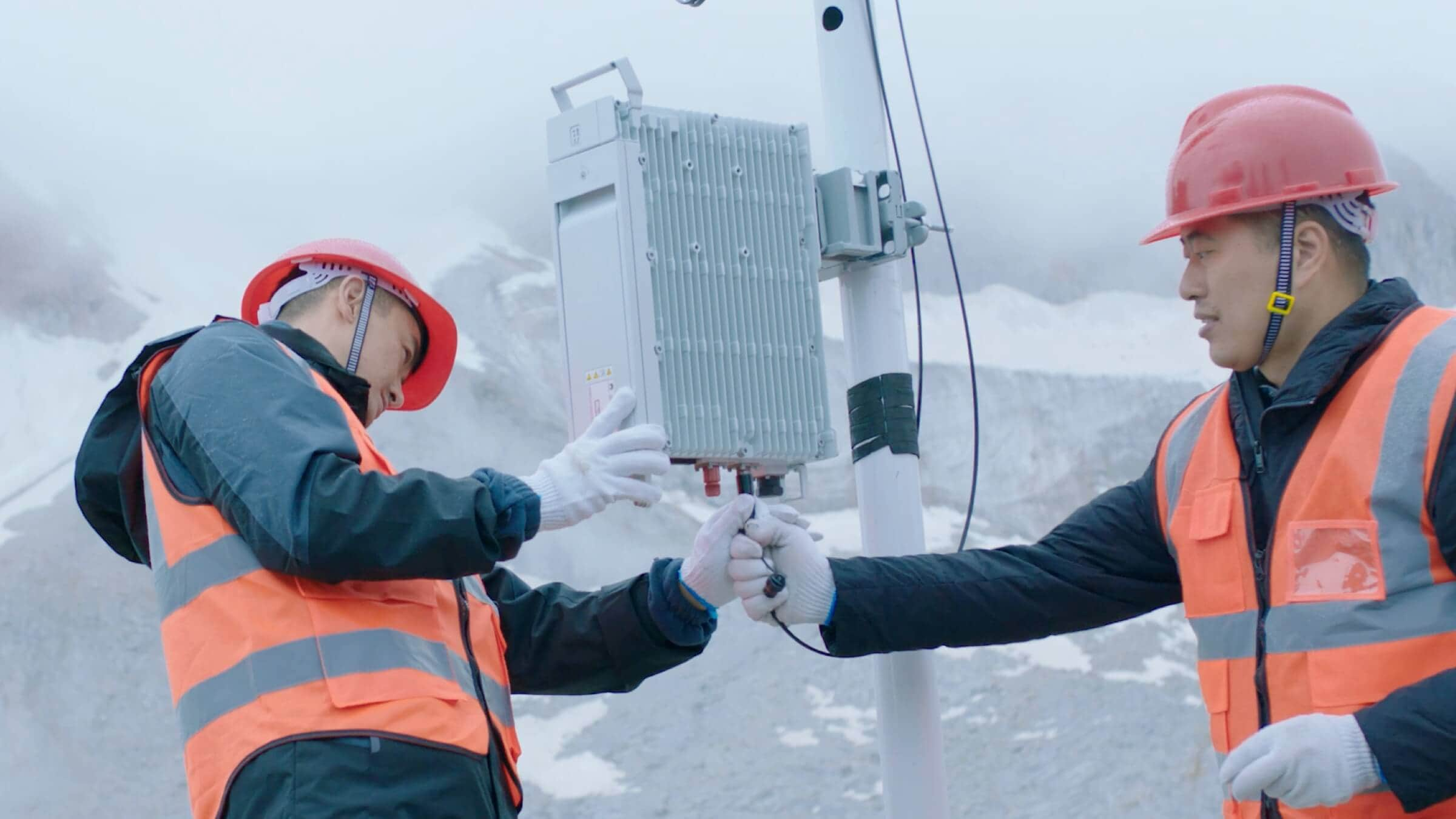Lifeline on Mount Qomolangma Pursuing the Brightest Light
China Mobile worked with Huawei to complete the construction and provisioning of the highest 5G base stations and F5G gigabit optical network on Mount Qomolangma. The operation was completed in the Advance Camp at an altitude of 6500 meters on April 30, 2020. With these base stations and the network in place, China Mobile was able to implement the coverage of the dual-gigabit network over the mountain. On the 60th anniversary of man's first reaching the peak from the north slope of Mount Qomolangma and the 45th anniversary of China's first accurate measurement and publication of the mountain's altitude, constructing a 5G network on the mountain tremendously improved communication for re-measuring the mountain's altitude in 2020. In the "5G Climbing Mount Qomolangma" program, China Mobile planned to build five 5G base stations in SA+NSA networking mode and build a gigabit private line and broadband network using 10G PON and Wi-Fi 6 technologies in the 5300-meter Base Camp, the 5800-meter Transition Camp, and the 6500-meter Advance Camp. Currently, China Mobile has already deployed a gigabit private line network and gigabit broadband network in the 5300-meter Base Camp by using Huawei 10G PON enterprise gateways and home ONTs of the OptiXstar series, which not only support HD video or VR webcasts, but also enable mountain climbers to make video calls, watch HD videos, and enjoy other online entertainment.
Pushing the Limits to Ensure Network Deployment
It is not the first time communication equipment has been installed on the mountain. However, most of the previously built base stations communicate with satellites without additional fibers. Compared with wireless communication modes such as satellite transmission, fiber transmission provides higher bandwidth and capacity, better immunity to interference, and a smaller transmission loss. This is the reason that the fiber transmission solution was chosen over others. However, the seemingly simple construction of a gigabit network in the 5300-meter, 5800-meter, and 6500-meter camps on the mountain is more challenging than expected. The mountain roads to the 5800-meter and 6500-meter camps are closed to traffic. As such, the near eight tons of supplies including the base station and power supply equipment have to be carried up the mountain by 46 yaks.
The biggest challenge is to transport and deploy fibers along the uneven mountain roads. In this Mount Qomolangma 5G project, 25 kilometers of optical cables weighing up to 600 kilograms need to be carried up the mountain along uneven and meandering footpaths. Such work has to be done fully manually as camps on Mount Qomolangma are located in the national nature reserve where heavy machinery is not permitted. Another challenge is that the fibers, which are made from silicon, easily freeze in the low temperature, which can cause them to break. The rubber sheath covering the optical cables may look intact, but the fiber cores inside may have broken. In this case, engineers need to manually spice fibers one by one in a small tent, which is time- and labor-consuming.
The daily life of construction staff in the base camp is relatively good. However, at an altitude of 5800 meters or higher, oxygen is scarce, and the temperature can drop to –20°C or lower. In such extreme conditions, it is difficult to even get a good sleep. Several engineers share one tent for warmth and may wake up every 2 to 3 hours at night. Electronic devices may also fail to start due to the low temperature. While they are sleeping, engineers have to keep laptops warm with their body temperature so that the laptops can boot normally the next day.
Easy Communication for the Altitude Measurement Project
Mount Qomolangma, which was originally used for providing supplies, has become the frontline headquarter, press center, and studio, greatly facilitating measurements and live broadcasts. First, all the measurement mountaineers, media reporters, and other staff can connect to the Internet through Huawei's large-capacity and high-concurrency OptiXstar 10G PON enterprise gateways over Wi-Fi. They can collaborate remotely with supporting teams and easily transmit onsite photos and videos. They can also hold high-quality video conferences with support staff to prepare for the altitude measurement webcast. Second, with the private lines' gigabit upstream transmission capability, news media such as China Central Television (CCTV) and Xinhua News Agency can broadcast 4K videos with multiple cameras stably and smoothly. The precise altitude measurement can be broadcast to the whole world in real time so that everyone can witness the event.
Last but not least, Huawei's OptiXstar 10G PON enterprise gatewayscan run stably for a long period of time even when the temperature drops below –40℃. This enables China Mobile to install outdoor gigabit private lines at the altitudes of 5300 m and 6500 m. The lines can send videos captured by ultra HD cameras to the cloud data center and provide 360-degree and VR live streams of Mount Qomolangma. With this immersive technology, audiences around the world can see the beauty of the mountain on their phones or TVs anytime anywhere. Through the 5G and F5G gigabit private lines, China Mobile can cover the summit of Mount Qomolangma with dual-gigabit networks for the first time and provide smooth and reliable network communication for the altitude measurement event.

